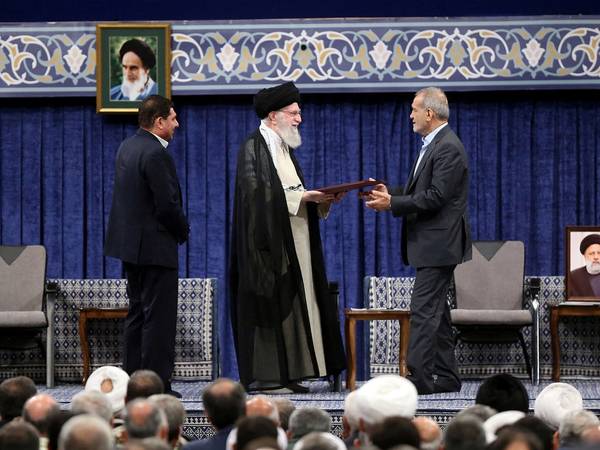Iran's Supreme Leader Ali Khamenei gave the official mandate for the presidency to Masoud Pezeshkian on Sunday in a ceremony attended by various officials and dignitaries.
During the ceremony -- called Tanfiz, Khamenei handed over a decree, known as the "decree of confirmation" or "decree of validation", to the president-elect, formally recognizing him as the legitimate president.
In fact, the official government news website, IRNA, used the word "approved" for Khamenei's endorsement of Pezeshkian as President, who is considered to be the chief executive from today, July 28. Therefore, the second inauguration event in the parliament in two days, is indeed a ceremonial swearing-in.
The ceremony started with Interior Minister Ahmad Vahidi delivering a report on the process of snap election following the death of late President Ebrahim Raisi, who died in a helicopter crash on May 19 along with his accompanying delegation including Foreign Minister Hossein Amir-Abdollahian.
Following Vahidi's speech, Mohammad Mohammadi Golpayegani, the head of Khamenei's office, read out the decree issued by the Supreme Leader of the Islamic Republic, officially confirming the appointment.
The new president then delivered a speech, emphasizing that he will follow Khamenei's orders and calling for the resolution of political differences. "The responsibility that the Constitution has placed on me is to move towards the clear path outlined by the Supreme Leader."
Khamenei also delivered a speech notably avoiding attacks on the United States but reiterating his rhetoric against Israel and support for anti-West, anti-Israel militant groups backed by Tehran. He also stated that relations with European countries are not Tehran's priority, while calling for stronger ties with regional neighbors.
In his address, Khamenei launched an unusually long and harsh critique of the pre-1979 monarchy, insisting that the Islamic Republic provides democratic choice, whereas the pro-West king, Mohammad-Reza Pahlavi, relied on the United States and Britain to stay in power.
This attack, during an inauguration ceremony, may reflect Khamenei's realization that the Islamic Republic has lost popularity with many Iranians, who have abstained from voting in several elections since 2020. Khamenei's authoritarian rule has increasingly used military force to quell anti-regime protests, killing thousands of citizens since 2017.
The ongoing economic crisis in Iran has fueled nostalgia for the prosperity of the Pahlavi era, especially in the 1970s.
The Tanfiz ceremony will be followed by Tahlif slated for Tuesday, when Pezeshkian swears in before the parliament. During Tahlif, the newly elected president takes an oath before the Parliament (Majlis) in the presence of the head of the judiciary and the members of the Guardian Council, promising to uphold the constitution and faithfully execute his duties as the head of state. Both ceremonies are essential in the transition of presidential power, ensuring both legal and symbolic legitimacy for the incoming president.
According to IRNA, over 2,500 attendees are expected, including national and military officials, heads and professors from religious and academic institutions, representatives from various sectors, families of martyrs, and foreign ambassadors stationed in Tehran.
The state media also said that 70 foreign delegations from different countries and international organizations will attend the swearing-in ceremony.
